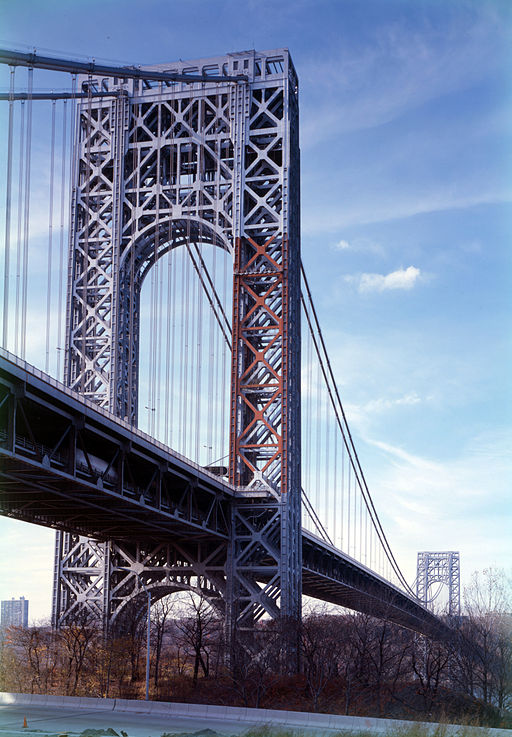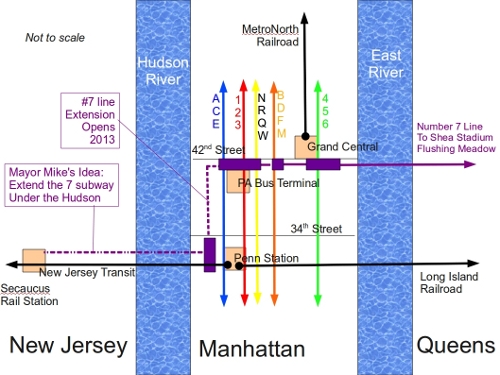 New Jersey Governor Chris Christie killed the new Hudson rail tunnel project for the second time. Since the $3 billion federal commitment to the project seems to now be gone, the project is unlikely to rise from the dead. It is hard to argue with Christie's objection to the original project: the costs kept going up and up, driven not by the costs of drilling the tunnels but all the underground work on the Manhattan side at Penn Station and Grand Central Terminal.
New Jersey Governor Chris Christie killed the new Hudson rail tunnel project for the second time. Since the $3 billion federal commitment to the project seems to now be gone, the project is unlikely to rise from the dead. It is hard to argue with Christie's objection to the original project: the costs kept going up and up, driven not by the costs of drilling the tunnels but all the underground work on the Manhattan side at Penn Station and Grand Central Terminal.
One could wish that Christie could have found a way to scale back the project without letting the federal funding opportunity lapse. I suppose voters can add it to the list of things to hold against him at the next election -- if anyone remembers.
Queue New York Mayor Mike Bloomberg to put a really interesting idea on the table: extend the Number 7 subway line to Secaucus. Could this be a stroke of genius? Consider:
- The subway extension would cost about half of what the Hudson rail project grew to: about $5.5 billion versus $11 billion and growing.
- Why? The stations at either end are already paid for. The new station for the 7 line at 34th Street and Eleventh Avenue is scheduled to open in 2013. The New Jersey Transit Secaucus Transfer Station, named for long-serving Senator Frank Lautenberg, already exists.
- The 7 line already interconnects to most of the key Manhattan-based public transit assets.
- The current terminus of the 7 line is at the gigantic underground complex that connects Eighth Avenue subways (A, C, and E lines), Seventh Avenue subways (1, 2, and 3 lines), Broadway subways (N, R, Q, and W lines), as well as the Port Authority Bus Terminal.
- The Fifth Avenue stop connects with the Sixth Avenue subways (B, D, F, and M lines).
- The Lexington Avenue stop connects with East Side subways (4, 5, and 6 lines) and Grand Central Terminal trains to the Bronx, Westchester County, and Connecticut.
- The 7 line goes on to Queens. Mets fans, take note.
- The 106-year-old signaling technology used by the subway system could handle many more trains per hour through the tunnels than conventional railroad signaling. Not a bad benefit, and a freebie!
- Yes, there could be better assistance for people with luggage and/or handicaps to get around the subway. It seems to me that this could be provided at much lower expense than constructing new underground rail stations.

If the 7 line extension ultimately goes through, it would not the the first time that harsh economic times redefined a major public transportation project. Construction started on the Hudson River Bridge (better known as the George Washington Bridge) in 1927, just as the Holland Tunnel opened. The Holland Tunnel was the world's first ventilated automobile tunnel. At 3,500 feet, the George Washington Bridge (GWB) was the longest suspension bridge in the world when it opened in 1931, doubling the previous record of 1,850 feet held by the Ambassador Bridge. The record held until the 4,760-foot Golden Gate Bridge opened in 1937.
The GWB was an ambitious project from the outset. Designers sited it far north of population centers in Manhattan to take advantage of the Palisades on the New Jersey side. The height permitted the approach roads to be built at grade rather than elevated, resulting in a significant savings in construction costs. It was envisioned to have two levels, 14 lanes of traffic, and stone facing for the towers.
As the Depression ground on, the GWB faced a funding crisis, not unlike today's Hudson Rail Tunnel project. Rather than abandon the project, officials decided to eliminate the stone facing, the second deck, and two of the lanes on the remaining deck.
In 1776, General George Washington fortified the Hudson River at Fort Washington (New York) and Fort Lee (New Jersey) in an unsuccessful attempt to deter the British from occupying Manhattan. In one of Washington's most important strategic retreats, he moved the American army across the Hudson between these sites, abandoning Manhattan, but saving the Continental Army. In 1931, the bridge honoring his name opened, connecting the same sites.
The Depression eased. The extra lanes on the upper level and the lower level were built, opening in 1946. But the towers remain, to this day, unadorned monuments of steel. Painted metallic gray, the structural skeleton and cables merge form and function so perfectly that the GWB was named a National Historic Civil Engineering Landmark in 1981, on the fiftieth anniversary of the opening.
Will we someday look back and admire the strength and simplicity of Mayor Bloomberg's suggestion to extend the Number 7 subway?
